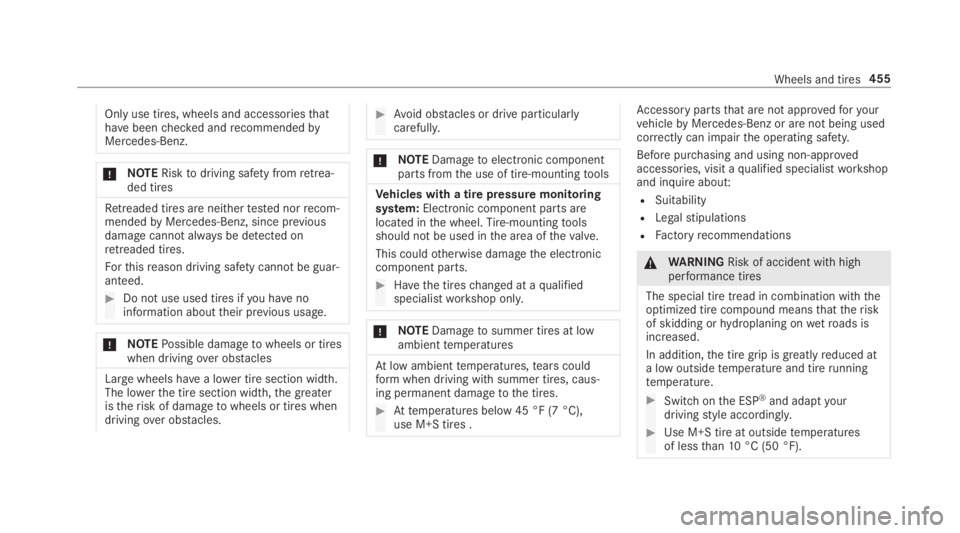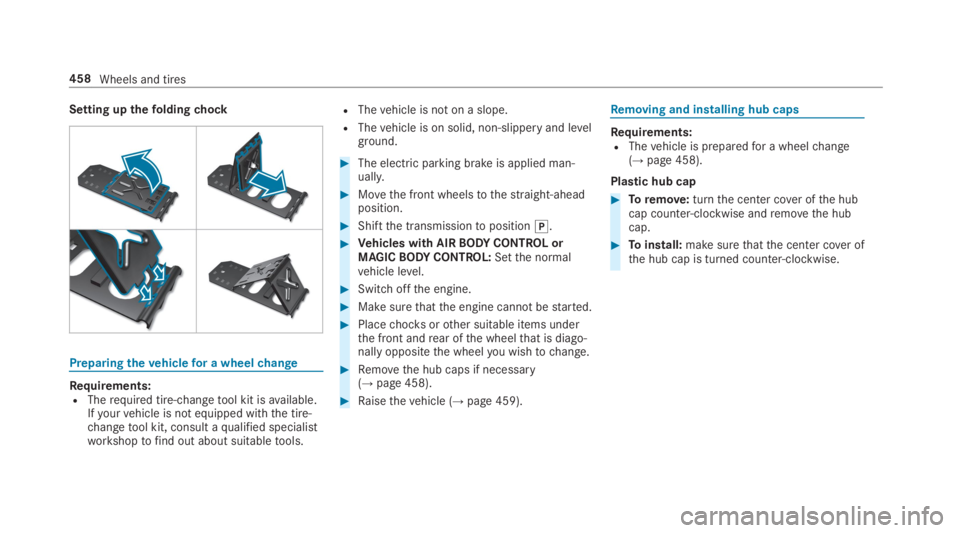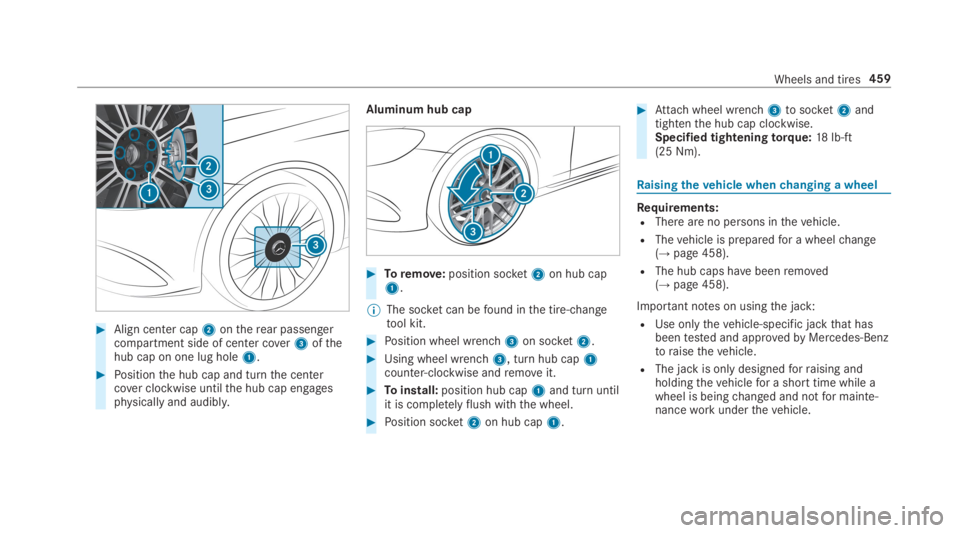2019 MERCEDES-BENZ S CLASS wheel
[x] Cancel search: wheelPage 456 of 578

Changing a wheel
Notes on selecting, installing andreplacingtires
Mercedes-AMGvehicles:observethe notes inthe Supplement. Otherwise,you may notrecog‐nize dangers.
You can askfor informationregarding permittedwheel/tire combinations at an authorizedMercedes-Benz Center.
&WARNINGRisk of accident duetoincor‐rect dimensions of wheels and tires
If wheels and tires ofthe wrong size areinstalled,the wheel brakes or wheel suspen‐sion components may be damaged.
#Alwaysreplace wheels and tires withthosethat fulfillthe specifications ofthe original part.
Whenreplacing wheels, make suretofitthecorrect:
RDesignation
RModel
Whenreplacing tires, make suretoinstallthecorrect:
RDesignation
RManufacturer
RModel
&WARNINGRisk of injurythroughexceed‐ingthe specified tire loadrating orthepermissible speedrating
Exceedingthe specified tire loadrating orthe permissible speedrating may leadtotiredamageandtothe tires bursting.
#Therefore, only use tire types and sizesapprovedforyourvehicle model.
#Observethe tire loadrating and speedratingrequiredforyourvehicle.
*NOTEVehicle and tire damagethroughtire types and sizesthat havenot beenapproved
For safetyreasons, onlyuse tires, wheelsand accessories which havebeen speciallyapprovedbyMercedes-Benzforyourvehicle.
These tires are specially adaptedtothe con‐
trol systems, such as ABS, ESP®and4MATIC, and marked asfollows:
RMO = Mercedes-Benz Original
RMOE = Mercedes-Benz Original Extended(run-flat tire onlyfor certain wheels)
RMO1 = Mercedes-Benz Original (only cer‐tain AMG tires)
Certaincharacteristics, such as handling,vehicle noise emissions, fuel consumption,etc. mayotherwise be adversely affected.Furthermore,other tire sizes couldresult inthe tiresrubbing againstthe body and axlecomponents when loaded. This couldresultin damagetothe tire orthevehicle.
454Wheels and tires
Page 457 of 578

Only use tires, wheels and accessoriesthathavebeenchecked andrecommendedbyMercedes-Benz.
*NOTERisktodriving safety fromretrea‐ded tires
Retreaded tires are neithertested norrecom‐mendedbyMercedes-Benz, since previousdamage cannot always be detected onretreaded tires.
Forthisreason driving safety cannot be guar‐anteed.
#Do not use used tires ifyou havenoinformation abouttheir previous usage.
*NOTEPossible damagetowheels or tireswhen drivingover obstacles
Large wheels havea lower tire section width.The lowerthe tire section width,the greateristherisk of damagetowheels or tires whendrivingover obstacles.
#Avoid obstacles or drive particularlycarefully.
*NOTEDamagetoelectronic componentparts fromthe use of tire-mountingtools
Vehicles with a tire pressure monitoringsystem:Electronic component parts arelocated inthe wheel.Tire-mountingtoolsshould not be used inthe area ofthevalve.
This couldotherwise damagethe electroniccomponent parts.
#Havethe tireschanged at aqualifiedspecialistworkshop only.
*NOTEDamagetosummer tires at lowambienttemperatures
Atlow ambienttemperatures,tears couldformwhen driving with summer tires, caus‐ing permanent damagetothe tires.
#Attemperatures below 45 °F (7 °C),use M+S tires .
Accessory partsthat are not approvedforyourvehiclebyMercedes-Benz or are not being usedcorrectly can impairthe operating safety.
Before purchasing and using non-approvedaccessories, visit aqualified specialistworkshopand inquire about:
RSuitability
RLegalstipulations
RFactoryrecommendations
&WARNINGRisk of accident withhighperformance tires
The special tire tread in combination withtheoptimized tire compound meansthattheriskof skidding orhydroplaning onwetroads isincreased.
In addition,the tire grip is greatlyreduced ata low outsidetemperature and tirerunningtemperature.
#Switch onthe ESP®and adaptyourdrivingstyle accordingly.
#Use M+S tire at outsidetemperaturesof lessthan10°C (50 °F).
Wheels and tires455
Page 458 of 578

Observethefollowing when selecting, installingandreplacing tires:
ROnly use tires and wheels ofthe same type(summer tires, winter tires, MOExtendedtires) andthe same make.
ROnly install wheels ofthe same size on oneaxle (left andright).
It is only permissibletoinstall a differentwheel size intheevent of aflat tire in ordertodrivetothe specialistworkshop.
ROnly install tires ofthe correct size ontothewheels.
RVehicles with a tire pressure monitoringsystem:All installed wheels must be equip‐ped with functioning sensorsforthe tirepressure monitoring system.
RAttemperatures below 45 °F (7 °C), use win‐ter tires or all-season tires marked M+Sforall wheels.
Winter tires bearingthe�Msnowflake sym‐bol in additiontothe M+S marking providethe best possible grip in wintryroad condi‐tions.
RFor M+S tires, only use tires withthe sametread.
RObservethe maximum permissible speedforthe M+S tires installed.
Ifthis is belowthevehicle's maximum speed,this must be indicatedbyan appropriatelabel inthe driver'sfield of vision.
RBreak in new tires at moderate speedsforthefirst 60 miles (100 km).
RReplacethe tires after sixyears atthe latest,regardless ofwear.
RWhenreplacing with tires that do notfea‐turerun-flatcharacteristics:vehicles withMOExtended tires are not equipped with aTIREFIT kit atthefactory.Equipthevehiclewith a TIREFIT kit afterreplacing with tiresthat do notfeaturerun-flatcharacteristics,e.g. winter tires.
For more information on wheels and tires, con‐tact aqualified specialistworkshop.
Be suretoalso observethefollowing furtherrelated subjects:
RNotes on tire pressure (→page 435)
RTireand Loading Information placard(→page442)
RTiresize designation, load-bearing capacity,speedrating and load index (→page449)
RTirepressuretable (→page 437)
Notes onrotating wheels
&WARNINGRisk of injurythrough differ‐ent wheel sizes
Interchangingthe front andrear wheels ifthewheels or tires havedifferent dimensionsmay severely impairthe drivingcharacteris‐tics.
The wheel brakes or wheel suspension com‐ponents may also be damaged.
#Rotatefront andrear wheels onlyifthewheels and tires are ofthe same dimen‐sions.
456Wheels and tires
Page 459 of 578

Thewear patterns onthe front andrear wheelsdiffer:
RFront wheelswear more onthe shoulder ofthe tire
RRear wheelswear more inthe center ofthetire
Onvehiclesthat havethe same size front andrear wheels,rotatethe wheels accordingtotheintervals inthe tire manufacturer'swarrantybook inyourvehicle documents. Ifthis is notavailable,rotatethe tiresevery3,000to6,000 miles (5,000to10,000 km),depending onthewear. Ensurethatthe directionofrotation is maintained.
It is imperativetoobservethe instructions andsafety notes on "Changing a wheel" when doingso Preparingthevehiclefor a wheelchange(→page 458).
Notes onstoring wheels
Whenstoring wheels, observethefollowingnotes:
RAfterremoving wheels,storethem in a cool,dry and preferably dark place.
RProtectthe tires from contact withoil, greaseor fuel.
Overview ofthe tire-changetool kit
Apart from some country-specificvariants,vehi‐cles are not equipped with a tire-changetool kit.For more information on whichtire-changetoolsarerequired and approvedfor performing awheelchange onyourvehicle, consult aqualifiedspecialistworkshop.
Required tire-changetools may include,forexample:
RJack
RChock
RLug wrench
RAlignment bolt
The tire-changetool kit is located underthetrunkfloor.
1Ratchet
2Alignment bolt
3Jacking support
4Jack
5Lug wrench
6Foldingchock
Wheels and tires457
Page 460 of 578

Setting upthefoldingchock
Preparingthevehiclefor a wheelchange
Requirements:RTherequired tire-changetool kit isavailable.Ifyourvehicle is not equipped withthe tire-changetool kit, consult aqualified specialistworkshoptofind out about suitabletools.
RThevehicle is not on a slope.
RThevehicle is on solid, non-slippery and levelground.
#The electric parking brake is applied man‐ually.
#Movethe front wheelstothestraight-aheadposition.
#Shiftthe transmissiontoposition�].
#Vehicles with AIRBODYCONTROL orMAGICBODYCONTROL:Setthe normalvehicle level.
#Switchoffthe engine.
#Make surethatthe engine cannotbestarted.
#Placechocksorother suitable items underthe front andrear ofthe wheelthat is diago‐nally oppositethe wheelyou wishtochange.
#Removethe hub caps if necessary(→page 458).
#Raisethevehicle (→page 459).
Removing and installing hub caps
Requirements:RThevehicle is preparedfor a wheelchange(→page 458).
Plastic hub cap
#Toremove:turnthe center cover ofthe hubcap counter-clockwise andremovethe hubcap.
#Toinstall:make surethatthe center cover ofthe hub cap is turned counter-clockwise.
458Wheels and tires
Page 461 of 578

#Align center cap2ontherear passengercompartment side of center cover3ofthehub cap on one lug hole1.
#Positionthe hub cap and turnthe centercover clockwise untilthe hub cap engagesphysically and audibly.
Aluminum hub cap
#Toremove:position socket2on hub cap1.
%The socket can befound inthe tire-changetool kit.
#Position wheel wrench3on socket2.
#Using wheel wrench3, turn hub cap1counter-clockwise andremoveit.
#Toinstall:position hub cap1and turn untilit is completelyflush withthe wheel.
#Position socket2on hub cap1.
#Attachwheel wrench3tosocket2andtightenthe hub cap clockwise.Specified tighteningtorque:18lb-ft(25 Nm).
Raisingthevehicle whenchanging a wheel
Requirements:RThere are no persons inthevehicle.
RThevehicle is preparedfor a wheelchange(→page 458).
RThe hub caps havebeenremoved(→page 458).
Important notes on usingthe jack:
RUse onlythevehicle-specific jackthat hasbeentested and approvedbyMercedes-Benztoraisethevehicle.
RThe jack is only designedforraising andholdingthevehiclefor a short time while awheel is beingchanged and notfor mainte‐nanceworkunderthevehicle.
Wheels and tires459
Page 462 of 578

RThe jack must be placed on afirm,flat andnon-slip surface. If necessary,use a large,flat, load-bearing, non-slip underlay.
RThefootofthe jack must be positionedverti‐cally underthe jack support point.
Rules of conduct whenthevehicle israised:
RNever placeyour hands orfeetunderthevehicle.
RNever lie underthevehicle.
RDo notstartthe engine and do notreleasethe electric parking brake.
RDo not open or close any doors orthe trunklid.
#Usingthe lug wrench, loosenthe wheel boltsonthe wheelyou wishtochangebyaboutone full turn. Do not unscrewthe bolts com‐pletely.
Position of jack support points
&WARNINGRisk of injuryfrom incorrectpositioning ofthe jack
Ifyou do not positionthe jack correctly atthe appropriate jacking point ofthevehicle,the jack could tip withthevehicleraised.
#Only positionthe jack atthe appropri‐ate jacking point ofthevehicle. Thebase ofthe jack must be positionedver‐tically underthe jacking point ofthevehicle.
460Wheels and tires
Page 463 of 578

*NOTEVehicle damage fromthe jack
Ifyou do not positionthe jack correctly atthe appropriate jack support point ofthevehicle,the jack could tipover withthevehi‐cleraised.
#The jack is designedexclusivelyforjacking upthevehicle atthe jack sup‐port points.
#Taketheratchet wrench out ofthe tire-changetool kit and place it onthe hexagonnut ofthe jack sothatthe letters "AUF" arevisible.
#Position jack2at jack support point1.
#Turnratchet wrench3clockwise until jack2sits completelyon jack support point1andthe base ofthe jack liesevenly ontheground.
#Continuetoturnratchet wrench3untilthetire israised a maximum of1.2 in (3 cm) offthe ground.
#Loosen andremovethe wheel (→page 461).
Removing a wheel
Requirements:RThevehicle israised (→page 459).
Mercedes-AMGvehicles:observethe notes inthe Supplement. Otherwise,you may notrecog‐nize dangers.
Whenchanging a wheel,avoid applying anyforcetothe brake discs, sincethis could impairthelevel of comfortwhen braking.
*NOTEDamagetothreading from dirt onwheel bolts
#Do not place wheel bolts in sand or ona dirty surface.
#Unscrewthe uppermost wheel bolt com‐pletely.
Wheelsand tires461